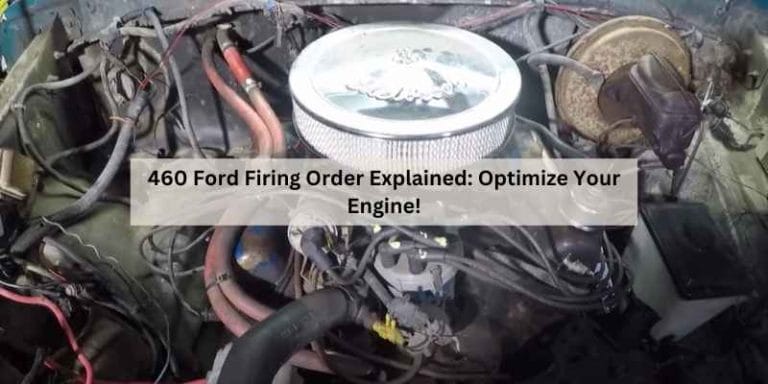P1747 Ford Error Code: Quick Fixes & Tips
The P1747 code in Ford vehicles signals a problem with the Electronic Pressure Control (EPC) solenoid circuit. This issue often stems from a wiring fault or a malfunctioning solenoid.
The P1747 code can lead to significant transmission issues if not addressed promptly. This trouble code typically appears in various Ford models and indicates a malfunction in the Electronic Pressure Control system. The EPC solenoid plays a critical role in regulating transmission fluid pressure, affecting shifting performance.
Drivers may experience rough shifting, slipping, or overheating due to this code. Diagnosing the P1747 code involves inspecting wiring connections, testing the EPC solenoid, and checking the Powertrain Control Module (PCM). Early identification and repair can prevent further damage and ensure smoother vehicle operation.
Introduction To P1747 Ford Error Code
The P1747 Ford error code indicates issues with the transmission. It often relates to the Electronic Pressure Control (EPC) solenoid. Common symptoms include:
- Rough engine performance
- Hard shifting during gear changes
- Frequent check engine light alerts
- Transmission overheating
Initial diagnosis steps can help identify the problem:
- Check for wiring issues around the EPC solenoid.
- Inspect the transmission fluid for contamination.
- Use a scan tool to read error codes.
- Test the voltage at the EPC solenoid.
Decoding P1747: What It Means
The P1747 code relates to the Electronic Pressure Control (EPC) solenoid. This component plays a crucial role in regulating transmission fluid pressure. A malfunction can lead to shifting issues. The EPC solenoid directly impacts how smoothly the vehicle shifts gears.
When the EPC solenoid fails, it can cause the transmission to overheat. This overheating may result in poor performance and increased wear. Drivers may experience rough shifts or even stuck gears. Addressing issues with the EPC solenoid is essential for maintaining a healthy transmission system.
Quick Fixes For P1747
Start by inspecting the wiring harness for any visible damage. Look for frayed wires or loose connections. Make sure the connectors are clean and secure.
If damage is found, consider repairing or replacing the affected sections. A multimeter can help check for continuity. This ensures the solenoid receives the correct signals.
For solenoid replacement, ensure the vehicle is off. Remove the old solenoid carefully. Check for any debris in the area. Install the new solenoid and make sure it fits snugly.
After installation, reconnect the wiring harness. Clear any error codes from the ECM. Test drive the vehicle to ensure proper operation.
Troubleshooting Tips For Persistent Issues
Using the right diagnostic tools is crucial for troubleshooting P1747 Ford issues. OBD-II scanners help read error codes quickly. They can also provide real-time data about your vehicle’s performance. For deeper insights, consider using a professional-grade scanner.
DIY repairs can save money, but they come with risks. Basic tools like multimeters and test lights are helpful for home mechanics. Yet, complex problems may require a professional technician. They have advanced tools and experience, ensuring accurate diagnostics and repairs.
| Aspect | DIY Repair | Professional Repair |
|---|---|---|
| Cost | Lower | Higher |
| Expertise | Basic | Advanced |
| Tools | Standard | Specialized |
| Time | Variable | Efficient |
Preventive Measures To Avoid P1747
Maintaining a regular maintenance schedule is essential to avoid the P1747 code. Check the transmission fluid regularly. Ensure the fluid level is adequate and the fluid condition is good. Change the fluid according to the manufacturer’s recommendations.
Monitor key components like the Electronic Pressure Control (EPC) solenoid. Inspect the wiring for signs of wear or damage. Ensure all connections are tight and clean. Regular diagnostics can help detect early issues.
Replace any faulty parts promptly. This proactive approach can prevent serious transmission problems. Keeping everything in top shape will enhance your vehicle’s performance and longevity.
Understanding The Cost Implications
The cost of repairing the P1747 Ford code can vary. DIY repairs might cost between $50 and $150. This includes tools and parts. Knowledge of car systems is essential for DIY work.
Professional services usually charge higher fees. Expect to pay $100 to $200 per hour for labor. Total costs can reach $500 or more depending on the issue. Finding a reliable mechanic is key to managing expenses.
Case Studies: Real-world Fixes
Success stories often highlight effective solutions for the P1747 code in Ford vehicles. Many users reported fixing the Electronic Pressure Control (EPC) solenoid issues. They replaced faulty wiring, which led to smoother transmission shifts.
Learning from failed attempts can be just as important. Some drivers ignored diagnostic codes, leading to more extensive damage. Regular maintenance and inspections can prevent these issues from escalating.
Sharing these experiences helps others understand the importance of addressing problems early. Reliable sources, such as forums and repair sites, provide valuable insights. Community support can lead to successful repairs and save money.
Future-proofing Your Ford Against P1747
Keeping your Ford running smoothly involves understanding P1747 issues. This code indicates a problem with the Electronic Pressure Control Solenoid. Upcoming technology in transmission care aims to address these issues effectively. Newer models may include advanced sensors for better diagnostics.
Staying informed on model-specific issues is essential. Regular updates from Ford can help owners understand their vehicles better. Utilizing online resources and forums can provide valuable insights. Engaging with other Ford owners can lead to shared knowledge and experiences.
| Technology | Benefits |
|---|---|
| Advanced Sensors | Improved diagnostics and early detection |
| Real-time Monitoring | Immediate alerts for potential issues |
| Software Updates | Enhanced performance and reliability |
Frequently Asked Questions
What Does Code P1747 Mean?
Code P1747 indicates a problem with the Electronic Pressure Control (EPC) solenoid in the transmission. This code typically signals a short circuit or wiring issue. Addressing this promptly can prevent further transmission complications. Always consult a professional for accurate diagnosis and repair.
What Is The Code U0101 On A Ford?
The U0101 code on a Ford indicates a loss of communication with the Transmission Control Module (TCM). This issue often stems from wiring problems, faulty connectors, or a malfunctioning TCM. Addressing this code typically requires diagnostic testing to determine the exact cause.
What Years Are Ford Dentsides?
Ford Dentsides refer to the sixth generation of the Ford F-Series, produced from 1973 to 1979. These trucks are known for their unique design and durability.
Why Are Ford Trucks Called Dentsides?
Ford trucks are called Dentsides due to their distinctive body style. This term refers to the sixth-generation F-Series models produced from 1973 to 1979. The design features a more pronounced dent in the sides compared to previous models, hence the nickname.
Conclusion
Understanding the P1747 code in Ford vehicles is crucial for effective troubleshooting. This code often signals issues with the Electronic Pressure Control Solenoid. Addressing these problems promptly can prevent further transmission damage. Always consult a professional for accurate diagnostics and repairs.
Keeping your vehicle in top shape ensures a smoother driving experience.





